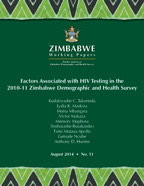
Abstract:
Zimbabwe has a high human immunodeficiency
virus (HIV) burden. It is therefore important
to scale up HIV testing and counselling (HTC)
as a gateway to HIV prevention, treatment and
care. The objective of this study is to
determine factors associated with HIV testing
uptake among adult men and women in Zimbabwe.
The study used data from 7,313 women and
6,584 men who completed interviewer-
administered questionnaires and who provided
blood specimens for HIV testing during the
2010-11 Zimbabwe Demographic and Health
Survey (ZDHS). Associations between socio-
demographic and sexual risk behaviours were
examined using the Chi-square test for
association and multivariate logistic
regression.
The study found that more women than men were
ever tested for HIV (61% versus 39%), which
was similar to findings for testing in the 12
months before the survey (40% versus 26%). In
the multivariate analysis, women who visited
antenatal care (ANC) had significantly higher
testing uptake, and men whose partners
attended ANC in the past two years had a
significantly higher testing uptake. For men,
testing uptake increased with increasing age
from age 20, and was particularly high for
men age 45-49, while, for women testing was
highest at age 20-29. Other
significant factors for HIV testing among
both women and men were
educational attainment, high wealth status,
currently/formerly being in union and being
HIV-infected. Despite higher testing levels
among those found to be HIV-infected, 26% of
women and 45% of men were never tested
for HIV.
ANC is an important gateway for HIV testing
among pregnant women, and this model can be
extended to their partners. Strategies aimed
at generally increasing HIV testing uptake
need to be adopted, particularly for men and
for lower-income and less educated
populations. The high proportion of
undiagnosed individuals highlights the need
for continued scale-up of HIV testing in
Zimbabwe.
 Factors Associated with HIV Testing in the 2010-11 Zimbabwe Demographic and Health Survey (PDF, 1833K)
Factors Associated with HIV Testing in the 2010-11 Zimbabwe Demographic and Health Survey (PDF, 1833K)
